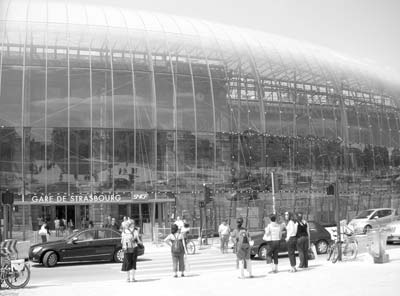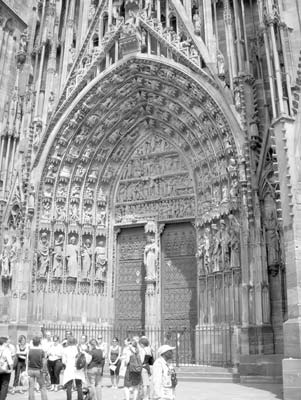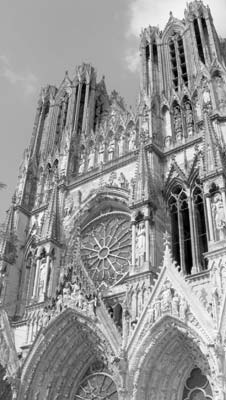Cities of TGV Est
This item appears on page 72 of the February 2008 issue.
Take one glance at the new timetable from Paris’ Gare de l’Est and you see that frequent 199-mph TGV Est trains reach Reims in 45 minutes, Strasbourg in two hours 20 minutes, Nancy in one hour 30 minutes, Metz in one hour 25 minutes and Luxembourg in two hours five minutes. The TGVs have opened for visitors the whole of northeastern France — the regions of Alsace, Lorraine and Champagne-Ardennes.
For a bonus, three to four daily TGVs from Charles de Gaulle airport train station take you directly to the scenic regions by avoiding downtown Paris train stations and joining the 199-mph Est Line shortly before the new Champagne-Ardenne TGV Station.
The airport chord westbound connects northeastern France with the 186-mph TGV Nord line for faster connections to and from Lille. For example, the trip Nancy-Lille takes three hours 20 minutes without having to change train stations in Paris. In Lille you can change to a Eurostar train to London or a Thalys to Brussels or Amsterdam.
Champagne-Ardenne
Reims (Rheims) train station, now a 45-minute commute from Paris, has dedicated two platforms to the new TGV service, making it easier to visit Reims’ (www.reims-tourisme.com) magnificent cathedral where 26 French kings were crowned. The cathedral, indeed most of the city, is less than a 20-minute walk from the station.
Others come to visit the miles of underground Champagne cellars that Dom Pérignon, the Champagne cellar master, originated. (“Come quickly, I am drinking the stars.”)
Although the Gothic Notre Dame Cathedral attracts hordes of visitors, most come only for the day. It is a shame they do not stay longer because when the day-tourists are gone, camaraderie runs high and visitors are welcome.
On the boulevard, cheerful residents flock to a line of diverse outdoor cafés that surpasses anything in Paris. Your choices are surprising, Champagne is the beverage of choice and the local white wines are excellent.
Because hotel prices in Reims are on average 40% lower than comparable Parisian hotels, one can consider staying in Reims and visiting Paris on a lark.
City of coronations
Once the bishop of Reims baptized Clovis, the young warrior who pushed the Visigoths all the way into Spain, Reims became a City of Coronations. Almost all the great kings of France were anointed here. The most moving coronation was that of Charles VII on July 17, 1425, which took place in the middle of the Hundred Years War in the presence of Joan of Arc.
Reims’ Notre-Dame Cathedral is not only a masterpiece of Gothic art (whose 800th anniversary will be celebrated in 2011) but a symbolic place in the kingdom of France. The interior is one of the greatest achievements of Gothic architecture. In the afternoon, the sun lights two rose windows on the west end of the nave and creates an awesome sight.
During the First World War, the cathedral was partly destroyed by shelling. On May 7, 1945, the document was signed that marked the surrender of Germany, and on July 8, 1962, the cathedral was the venue of General de Gaulle and Chancellor Konrad Adenhauer’s Franco-German Reconciliation.
Reims’ Cathedral of Notre-Dame, the former Abbey of Saint-Rémi and the Palace of Tau together are listed as a UNESCO World Heritage Site. Skilled stonemasons built Saint-Rémi Basilica just 1,000 years ago in 2007. Tau Palace, dating from 1690, is the former palace of the bishop of Reims. It houses some of the cathedral’s original statuary.
In Lorraine, the citizens of Nancy, the capital, boast that their elegant Place Stanislas is one of the most beautiful town squares in all of Europe and add that their city is full of Art Nouveau treasures such as the Musée de l’École de Nancy.
Metz’ stunning St. Stephen’s Cathedral, which has the second-tallest nave in Europe, also has Chagall windows shining among its 70,000 square feet of leaded glass artistry. This glass work makes it the most illuminated cathedral in France and causes the cathedral to be known as “God’s Lantern.”
Alsace
Strasbourg (www.ot-strasbourg.fr) is famous for 1) being the picture-book capital of Alsace, 2) storks and 3) the birth of pâté de foie gras.
Strasbourg’s train station has been renovated and covered with a spectacular glass-and-steel arch that resembles a shimmering bubble. The station is the hub for 50 TGV departures, including direct trains to Paris. Other TGVs race to Munich along the French-German Karlsruhe/Stuttgart route and to Zürich aboard French-Swiss Lyria service rerouted via Basel.
Strasbourg is a special city because it is the confluence of two historically acrimonious cultures. Although Alsace was a German-dialect-speaking region for several periods in its history, all Alsatians today speak French. About 25% of the local population is fluent in Alsatian as a mother tongue or German as a second language. Many speak and understand English. You hear both French and Alsatian spoken on the streets of the regional capital.
Strasbourg’s location on the border with Germany leads German visitors to flood Strasbourg’s scenic quarters and patronize “Vinstubs” serving German as well as French cuisine. Menus in the tourist area describe the meals in German as well as French — and frequently English, as well.
The Grande Ile (Big Island) is the epicenter of ancient and modern-day Strasbourg and the first location in France to be recognized as a UNESCO World Heritage Site.
Strasbourg’s red-sandstone, largely Romanesque Notre-Dame Cathedral is remarkable for its famous Gothic spire that you can not only use for navigation around city streets but also sight from much of the Alsace Plain. The High Gothic west front is decorated with sculptures from several time periods.
Inside the south portal of the Cathedral, crowds gather at midday (12:30 p.m.) to watch allegorical figures dancing on the face of the 1858 Astronomical Clock. The figure of Death sounds the hours and the clock chimes quarter hours.
Of the host of attractive buildings fronting the Place de la Cathedral, the most eye-catching is the magnificent 1489 Kammerzell House, the most beautiful in Strasbourg, next to the busy Strasbourg Tourist Office.
Petite France is the city’s well-preserved historic core and once the home of fishermen, tanners and millers. Engineers built locks on the arms of the Ill River so that shipping from the Rhine River could reach the back doors of nearly every shop. Boat cruises reveal beautifully preserved half-timbered houses and parks beside the river. Gabled Renaissance houses reflect in the green waters of the Ill. You pass under bridges, through locks and below the glass shell of the seat of the European Parliament.
Luxembourg
Luxembourg is a one-hour-40-minute trip from Metz by TGV Est or two hours five minutes from Paris (down from three hours 40 minutes).
The capital city’s train station has been well modernized to accommodate the new arrivals of TGVs. A new underground floor now connects the platforms with the forecourt. The platforms have been renovated and their canopy replaced with a new model, partially made of glass. The Welcome & Sales Center has been expanded to cover the entire surface area of the station’s lateral hall.
I especially thank Chris Lazarus, spokesperson for Rail Europe, for personally arranging hosted accommodations in Reims and Strasbourg. Rail Europe (www.raileurope.com) provided my France Pass and obligatory TGV reservations.
In Reims, I highly recommend the Best Western de la Paix (www. bestwestern-lapaix-reims.com), a 3-star hotel with 5-star comfort, with rates from €150 (near $205); there’s a 10% reduction for AARP members. In Strasbourg I stayed at the Romantik Hotel Beaucour (www.maison-kammerzell.com), with rates from €186 ($255), on the rim of Petite France.



